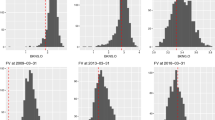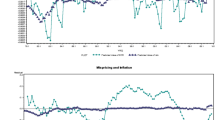Abstract
Using a unique dataset of appraised values and transaction prices, this paper investigates whether systematic over-appraisals could have been at the heart of the 2005/2006 German open-end fund crisis. Because sold properties are valued more closely to market values than unsold properties, we develop a hedonic pricing model that controls for sample selectivity. The resulting estimates of prices achievable in the market are then compared to appraised values. Our results show that the properties held by open-end real estate funds were likely to have been overvalued prior to the crisis. This supports the view that a fundamentally justified run was at the heart of the 2005/2006 crisis, and it challenges the effectiveness of current valuation practices.




Similar content being viewed by others
Notes
German investment law explicitly provides for the possibility to close a fund due to liquidity problems. However, since the introduction of OEREFs in 1959, this rule had been not been tested prior to the 2005/2006 crisis.
Of course, the two views presented here are not mutually exclusive. In fact, bad fundamentals and a speculative momentum may well have interacted during the crisis.
By the end of 2009 only two German REITs were issuing shares, i.e. Alstria Office and Fair Value.
Until the end of 2007 sale prices were allowed to “marginally” fall short of valuations.
Of course, one could follow (1981) in arguing that the volatility of market prices may actually be too high relative to the volatility of the underlying income stream. Appraisals would then be merely trying to eliminate excess volatility.
Note that there can be a valuation mismatch either with or without smoothing and lagging being present.
By excluding observations of appraised values shortly before a transaction took place, we are able to rule out the “information spill-over” hypothesis. Excluding observations prior to sales furthermore reduces the likelihood of dealing with appraised values that are influenced by clients.
By the end of 2007, the IPD database contained about 3,800 properties, with a total market value of EUR 44.5bn. Thereof, office properties (47%) accounted for the largest fraction in volume terms, followed by other properties (22%), retail (19%) and residential properties (11%). In terms of investor coverage, properties of the IPD database were held by open-end funds (42%), insurance and pension funds (39%), asset managers (13%), and special real estate funds (6%).
RICS/IPD (2008) exclude appraisal based values three months prior to a sale.
For a review of the literature on hedonic pricing models see Malpezzi (2002)
Frankfurt hosts the largest fraction of properties in our sample. The dummy variable is omitted from our regression equation.
Fisher et al (2003, 2007) use the midpoint assumption to identify the seller’s and buyer’s reservation price equation, respectively. Since our primary goal is to compensate for sample selection bias, rather than to identify the reservation price equation on either side of the market, any alternative assumption about bargaining power would be suitable.
Actually, we only need the inverse Mills ratio for the sold properties.
In normal times, property valuations tend to be conservative. That is, on average there will be a slight undervaluation compared to what can be expected in the market.
This equals the predicted error from our hedonic regression for the combined sample.
The sample size is reduced compared to the naive specifications, as we consider only valuation reserves within the boundaries of +/-25%
For instance, the Swiss model confines share redemptions to the end of the calender year, in addition to having a one year notice period.
References
Allen, F., & Gale, D. (1998). Optimal Financial Crisis. Journal of Finance, 53(4), 1245–1284.
Bannier, C.E., Fecht, F., Tyrell, M. (2008). Open-End Real Estate Funds in Germany – Genesis and Crisis. Kredit und Kapital, 40(1), 9–36.
Baum, A., Crosby, N., Paul Gallimore, A.G., McAllister, P. (2000). The Influence of Valuers and Valuations on the Workings of the Commercial Property Investment Market. Royal Institution of Chartered Surveyors/Investment Property Forum, London.
Breunig, R., & Mercante, J. (2009). The Accuracy of Predicted Wages of the Non-employed and Implications for Policy Simulations from Structural Labour Supply Models.Australian Government, Treasury Working Paper, March 2009.
Brown, G., & Matysiak, G.A. (2000). Sticky Valuations, Aggregation Effects, and Property Indices. Journal of Real Estate Finance and Economics, 20(1), 49–66.
Clayton, J., Geltner, D., Hamilton, S.W. (2001). Smoothing in Commercial Property Valuations:Evidence from Individual Appraisals. Real Estate Economics, 29(3), 337–360.
Crosby, N. (2007). German Open Ended Funds: Was there a Valuation Problem? Working Papers in Real Estate and Planning, No. 05/07, University of Reading.
Deborah, L., & Schuck, E. (2005). The Influence of Clients on Valuations: The Clients’ Perspective. Journal of Property Investment & Finance, 23(2), 182–201.
Diamond, D.W., & Dybvig, P.H. (1983). Bank Runs, Deposit Insurance, and Liquidity. Journal of Political Economy, 91(3), 401–419.
Diaz, J., & Wolverton, M. (1998). A Longitudinal Examination of the Appraisal Smoothing Hypothesis. Journal of Real Estate Economics, 26(2), 349–358.
Downie, M.L., Schulte, K.W., Thomas, M. (1996). 8. European Valuation Practice, (pp. 125–152). Germany: E & FN Spon, London.
Edelstein, R.H., & Quan, D.C. (2006). How Does Appraisal Smoothing Bias Real Estate Returns Measurement?. Journal of Real Estate Finance and Economics, 32, 41–60.
European Commission ed. (2008). Expert Group Report Open End Real Estate Fund. March 2008, avaliable at:. http://ec.europa.eu/internal_market/investment/docs/other_docs/expert_groups/report_en.pdf(02.10.2008).
Fisher, J., Gatzlaff, D.H., Geltner, D., Haurin, D. (2003). Controlling for the Impact of Variable Liquidity in Commercial Real Estate Price Indices. Real Estate Economics, 31(2), 269–303.
Fisher, J., Geltner, D., Pollakowski, H. (2007). A Quarterly Transactions-based Index of Institutional Real Estate Investment Performance and Movements in Supply and Demand. The Journal of Real Estate Finance and Economics, 34(1), 5–33.
Geltner, D. (1989). Estimating Real Estate – Systematic Risk from Aggregate Level Appraisal-based Returns. Journal of the American Real Estate and Urban Economics Association, 17(4), 463–481.
Geltner, D., MacGregor, B.D., Schwann, G.M. (2003). Appraisal Smoothing and Price Discovery in Real Estate Markets. Urban Studies, 40(5–6), 1047–1064.
Glaesner, S.M. (2009). Appraisal Within Open-End Real Estate Funds: Evidence on Biased Appraisals in Fund Crisis Year 2006. mimeo, European Business School International University, Eltville.
Greene, J.T., & Hodges, C. W. (2002). The Dilution Impact of Daily Funds Flows on Open-end Mutual Funds. Journal of Financial Economics, 65 (1), 131–158.
Heckman, J.J. (1974). Shadow Prices, Market Wages and Labor Supply. Econometrica, 42(4), 679–694.
Heckman, J.J. (1979). Sample Selection Bias as a Specification Error. Econometrica, 47(1), 153–161.
Jacklin, C.J., & Bhattacharya, S. (1988). Distinguishing Panics and Information-based Bank Runs: Welfare and Policy Implications. Journal of Political Economy, 96(3), 568–592.
Kilbinger, S.S. (2006). Run on German Real Estate Funds Exposes Flaws in Regulations. The Wall Street Journal Online. January 31.
Malpezzi, S. (2002) In Kenneth, K.G., & OSullivan, A. (Eds.), Hedonic Pricing Models: A Selective and Applied Review (pp. 67–89). Oxford: Blackwell Science Ltd.
Maurer, R., Reiner, F., Rogalla, R. (2004). Return and risk of German open-end real-estate funds. Journal of Property Research, 21(3), 209–233.
McAllister, P., Baum, A., Crosby, N., Gallimore, P., Gray, A. (2004). Appraiser Behaviour and Appraisal Smoothing: Some Qualitative and Quantitative Evidence. Journal of Property Research, 20(3), 261–280.
McParland, C., Adair, A., McGreal, S. (2002). Valuation Standards – comparison of four European countries. Journal of Property Investment an Finance, 20(2), 127–141.
RICS/IPD (2008). Valuation and Sale Price Report 2008. November 2008, avaliable at: (01.05.2009).
Sebastian, S., & Strohsal, T. (2011). German open-ended real estate funds. In W. Maennig & T. Just (Eds.), Unterstanding German real estate markets. Heidelberg: Springer.
Sebastian, S., & Tyrell, M. (2006). Open-End Real Estate Funds: Diamond or Danger? Working Paper Series: Finance and Accounting, No. 168, Goethe Universität, Frankfurt am Main.
Shiller, R.J. (1981). Do Stock Prices Move Too Much to be Justified by Subsequent Changes in Dividends?. American Economic Review, 71(3), 421–436.
Tobin, J. (1958). Estimation of relationships for limited dependent variables. Econometrica, 26(1), 24–36.
Wolverton, M.L., & Gallimore, P. (1999). Client Feedback and the Role of the Appraiser. Journal of Real Estate Research, 18(3), 415–432.
Author information
Authors and Affiliations
Corresponding author
Additional information
We thank the IPD Investment Property Databank for generous access to their database; especially Alexander Bauer, Lars Dierkes, Björn-Martin Kurzrock, Daniel Piazolo, Julius Stinauer and Matthias Thomas for excellent support and great hospitality at IPD. We are grateful to Neil Crosby, Andreas Hackethal, Jan Pieter Krahnen, David Nicolaus and the anonymous referees for valuable comments and suggestions; and especially to René-Ojas Woltering for outstanding research assistance. The views expressed in this article are those of the authors only and do not necessarily reflect the views of the European Central Bank. Any errors or omissions are the responsibility of the authors.
Rights and permissions
About this article
Cite this article
Weistroffer, C., Sebastian, S. The German Open-End Fund Crisis – A Valuation Problem?. J Real Estate Finan Econ 50, 517–548 (2015). https://doi.org/10.1007/s11146-014-9485-9
Published:
Issue Date:
DOI: https://doi.org/10.1007/s11146-014-9485-9
Keywords
- Appraisal-based valuation
- Transaction-based valuation
- Hedonic pricing
- Commercial real estate
- Open-end real estate funds




